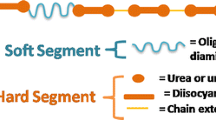Summary
Swelling has long been used in the study of elastomeric networks. In the case of stress-strain measurements on swollen networks, the most important observation was the decrease of the Mooney constant 2C2, which is widely used to represent the magnitude of the departure of an observed stress-strain isotherm from that predicted by the simplest molecular theories. Swelling equilibrium data were generally analysed by the Flory-Rehner equation for affine networks simply to obtain a measure of the degree of cross-linking. The advent of model networks whose structures are well known and of a new theory due to Flory constitute great improvements for the study of rubberlike elasticity. In this, new context, swelling can be used to obtain additional important molecular information through both uniaxial extension of swollen samples and swelling equilibrium. In particular, the relation between the main parameter κ characterizing the local constraints on junction fluctuations in the Flory theory, the extent of swelling, and the molecular weight between cross-links can be probed.
Similar content being viewed by others
References
J. E. MARK, Makromol. Chem., Suppl. 2, 87 (1979).
J. E. MARK, Adv. Polym. Sci., 44, 1 (1982).
P. J. FLORY and B. ERMAN, Macromolecules, 15, 800 (1982).
B. ERMAN and P. J. FLORY, Macromolecules, 15, 806 (1982).
P. J. FLORY, Proc. R. Soc. Lond., A 351, 351 (1976).
P. J. FLORY, Macromolecules, 15, 99 (1982).
G. RONCA and G. ALLEGRA, J. Chem. Phys., 63, 4990 (1975).
J. E. MARK, Rubber Chem. Technol., 48, 495 (1975).
J. P. QUESLEL and J. E. MARK, manuscript in preparation.
R. W. BROTZMAN and B. E. EICHINGER, Macromolecules, 15, 531 (1982).
P. J. FLORY, “Principles of Polymer Chemistry”, Chapters 12 and 13, Cornell University Press, Ithaca, New York (1973).
B. E. EICHINGER and P. J. FLORY, Trans. Farad. Soc., 64, 2035 (1968).
P. J. FLORY and J. REHNER, J. Chem. Phys., 11, 512, 521 (1943).
L. R. G. TRELOAR, “The Physics of Rubber Elasticity”, Chapter 7, Clarendon Press, Oxford (1975).
J. E. MARK and J. L. SULLIVAN, J. Chem. Phys., 66, 1006 (1977).
J. E. MARK and Z.-M. ZHANG, J. Polym. Sci., Polym. Phys. Ed., 21, 000 (1983).
Author information
Authors and Affiliations
Rights and permissions
About this article
Cite this article
Queslel, J.P., Mark, J.E. Characterization of elastomeric network structures using the effects of swelling on stress-strain isotherms and the extents of swelling at thermodynamic equilibrium. Polymer Bulletin 10, 119–125 (1983). https://doi.org/10.1007/BF00275844
Accepted:
Issue Date:
DOI: https://doi.org/10.1007/BF00275844




